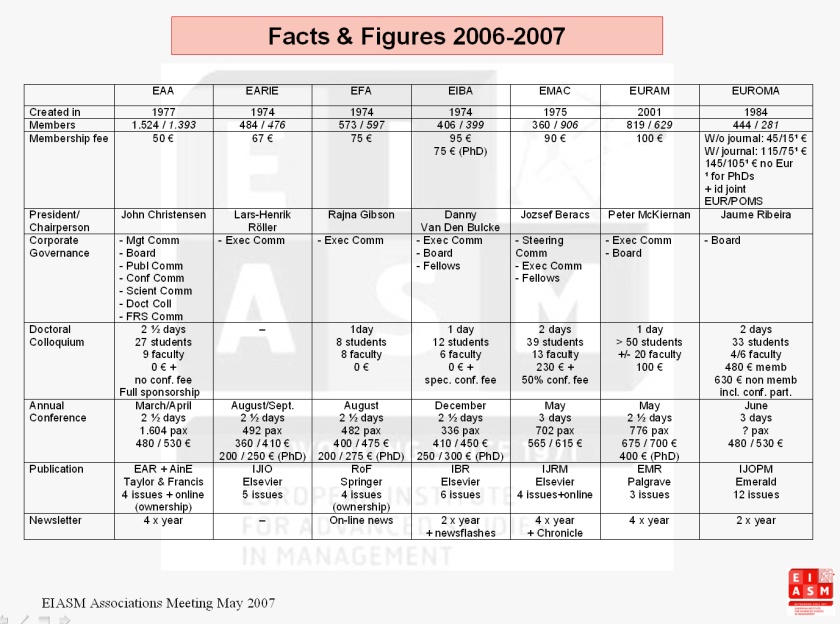EIBA-zine - Issue No. 2 - December 2005 (printable version)
EIBA-zine - Issue No. 3 - October 2006 (printable version)
EIBA-zine - Issue No. 4 - October 2007 (printable version)
EIBA-zine - Issue No. 5 - November 2008 (printable version)
Special Issue: A Tribute to John H. Dunning - Editor: Danny Van Den Bulcke (printable version)
EIBA-zine - Issue No. 6 - November 2009 (printable version)
by Danny Van Den Bulcke Most members of EIBA are aware of the fact that the secretarial work is ‘outsourced’ to the European Institute of Advanced Studies in Management (EIASM). The Executive Secretary of EIBA, Nicole Coopman, belongs to EIASM, just like her predecessor, Gerry Van Dyck – who followed EIBA from its early years until the middle of the 1990s – and Marion Hebbelynck, who is in charge of the doctoral tutorials. The staff of EIASM takes care of six other European academic associations which are active in the domain of business and management, i.e. EAA (European Accounting Association), EARIE (European Association for Research in Industrial Economics), EFA (European Finance Association), EMAC (European Marketing Academy), EURAM (European Academy of Management), EUROMA (European Operations Management Association) and EDAMBA (European Doctoral Programmes Association in Management and Business Administration) . In November 2005 EIASM for the first time held a meeting about the rationalization of conference organization to which the presidents or chairpersons of the seven associations were invited. The purpose of the meeting was to stress the importance of collaboration and networking between associations. One of EIASM’s aims is to bring the different networks closer and create a ‘network of networks’. The collaboration among the academic associations was situated at three different levels: the sharing of services and administration, the sharing of best practices by mutual learning and content generation by interdisciplinary activities and possible participation in EIASM’s scientific committee. In March 2006 and May 2007, a second and third follow up meeting took place in Brussels. Like before a number of common issues were discussed such as: the annual conferences (organisation, quality level, fees, format, no shows, copyright, sponsorship), the membership (development, retention, fee collection), the house journal (relationships with publishers, quality of papers, ranking/positioning), etc. The topics that were dealt with in this third meeting consisted of the presentation of EIASM’s product portfolio and its services to the associations, the administrative role of EIASM, the collaborations and exchanges among the associations and the academic activities beyond administrative support. While these deliberations cannot be reported in detail here, it might be interesting for EIBA members to situate our organization in comparison with the European ‘sister’ associations for some basic criteria. The enclosed table, where EIBA is mentioned right in the middle, shows a.o. that our academy was one of the first associations established in 1974 and that in terms of membership we are one of the smallest ones, based on figures for 2006 and the beginning of 2007. While EIBA, given the limitations of its interdisciplinary character is doing relatively well, these facts and figures should not be interpreted as if we cannot learn from other academic associations, even when they have many more members and benefit from important sponsorships which are out of reach for us.
|
| Top |
